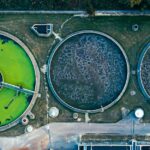The use of conditioning tanks for reagent addition at the beginning of flotation circuits has been standard practice for decades in the mining and refining industry. Today, new developments are making conditioning more efficient and effective, further cementing their necessity in all flotation circuit designs. Dynamix provides engineered solutions to meet the unique conditioning tank agitators requirements for all sizes and types of conditioning tanks. Our GMX and NMX agitator lines have the versatility to face these unique challenges.
How Conditioning Affects Flotation Circuit Operations
Froth flotation is often the only economically viable option for selective separation of complex ores. The process relies on collectors, reagents that bind with the minerals in the slurry to facilitate separation. These reagents are often added in conditioning tanks before the flotation circuit to allow for the necessary reaction time. Conditioning tank agitators provide the blending and solids suspension necessary to maximize contact between the minerals and the collectors.
Conditioning tanks serve a secondary purpose as a buffer before slurry enters the first flotation cell. Feed slurry can enter at different flow rates with varying compositions. The conditioning tank allows for a homogeneous blend to be fed to the flotation circuit at a constant rate, allowing for optimal process control. A properly controlled condition tank reduces operating costs, increases process performance, and improves circuit control. Choosing a suitable agitator is key to successful conditioning tank operation.
How Optimal Agitation Improves Conditioning Effectiveness
Inadequate or poorly optimized conditioning tank agitators lead to various issues propagating through the flotation circuit and reducing efficiency and mineral recovery. Conditioning tank agitators must provide a uniform solids suspension in order to maximize contact between collectors and minerals while also reducing sedimentation. The buildup of fine ground ore on the tank bottom will, in effect, reduce tank volume and eventually requires a process stoppage for manual removal.
Conditioning tank agitators also blend incoming slurry in order to achieve a homogeneous composition. As a result, this increases contact between reagents and the slurry while also buffering the input to the flotation circuit. Proper agitation will provide optimal blending due to ensuring a large area of influence. This prevents short-circuiting and dead spots that would result in reduced reaction rates and inconsistent feed to the flotation circuit.
How Dynamix Provides the Best Conditioning Tank Agitators
At Dynamix, our team of engineers designs custom conditioning tank agitators. We provide more efficient solutions for your process requirements by optimizing impeller configuration, drive power, and gear configuration. Our agitators will increase your process efficiency through reduced energy use and smaller drive power requirements. We also have abrasion-resistant coatings for any applications that will extend the life of conditioning tank agitators in demanding applications.
Our engineers understand the complex mixing requirements for pre-flotation conditioning tanks. We can develop the optimal solution for your process, no matter how demanding. Our team has extensive experience in mining and refining processes of all types. We can supply agitators for any stage of the process, from the large-scale NMX and GMX agitators as well as our utility mixer lines. Reach out to Dynamix today to learn more about how we can help optimize your process.





